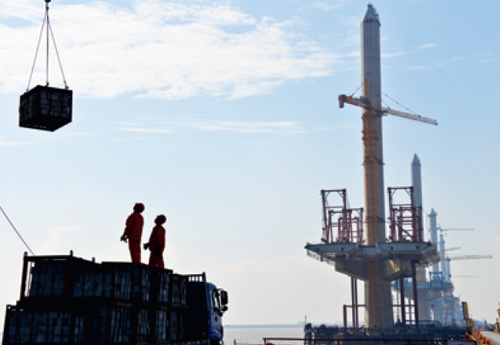|
 |
|
TOWERING TASK: Workers appear close by the main tower of the Jiaxing-Shaoxing (Jiashao) Bridge on the Hangzhou Bay, east China's Zhejiang Province, on February 22. As the second cross-sea bridge spanning the Hangzhou Bay, the Jiashao Bridge will halve the travel time between Shaoxing in Zhejiang and Shanghai to 1.5 hours (XUYU) |
As the end of the year is drawing near, Li Xuesong breathed a sigh of relief, for China's economy had finally bottomed out and began to rebound after a slowdown spanning seven seasons.
It is still hard to say how long the rebound will last. At the conference analyzing and forecasting China's economy and the book launch for the Blue Book on China's Economy in 2013 held on December 5, Li, Deputy Director of the Institute of Quantitative and Technical Economics at the Chinese Academy of Social Sciences, suggested the foundation for economic recovery was still weak and uncertain. "It depends on international economic factors and domestic economic policies," said Li.
At the 2012 session of the National People's Congress, Premier Wen first lowered China's economic growth target to 7.5 percent, which was decided upon by the National Development and Reform Commission (NDRC).
The economic growth target had been pegged at 8 percent in the past few years. The lower expectation for 2012 was no surprise. China's economic growth rate had been on the decrease since the fourth quarter of 2010, and there were no signs that the slowdown would see a reversal any time soon.
Distressed by the European sovereign debt crisis and the global economic slowdown, many believed China's economy could suffer a hard landing. No economists and government officials could safely say that wouldn't be the case.
Under such circumstances, the Chinese Government laid emphasis on maintaining steady growth by strengthening economic policies, expanding domestic demand and stabilizing overseas demand.
In 2012, China reduced deposit and loan rates twice to create a looser credit environment for enterprises and lowered deposit reserve ratios on two occasions to free up nearly 1 trillion yuan ($158.7 billion) in liquidity.
Meanwhile, the government has been striving to enlarge investment by speeding up project approvals. On May 20 alone, the NDRC gave the green light to over 100 investment projects. The newly approved projects in 2012 have exceeded 1 trillion yuan. In addition, the Ministry of Finance released new export rebate policies to stimulate exports.
With these measures, several major economic indicators, like industrial added value, investment, consumption and exports, eventually began to rebound in August.
"The GDP is predicted to grow by 7.7 percent this year," according to Li, which is higher than the 7.5-percent goal set at the beginning of the year.
Yao Jingyuan, a researcher at the Counselors' Office of the State Council, said it wasn't easy for China to meet its 7.5-percent goal in a fragile recovery and amid rising protectionism.
As economic growth gradually picks up, inflation has been effectively contained in 2012. The consumer price index fell from 4.5 percent in January to 1.7 percent in October, a record low in the past decade after experiencing negative growth for four months.
Alleviating inflation not only allows the Chinese Government to spare more energy to stabilize economic growth, but also reduces complaints of rising price levels.
"Though China's economy has bottomed out, there are still two pressing problems. For one, the economy is still expanding at a relatively low pace and the foundation for a recovery is weak, especially because of the uncertainty of overseas demand," said Li. "For another, excess production capacity is undermining the economic effectiveness of enterprises."
"If the situation in the euro zone doesn't worsen, if the United States can appropriately deal with the so-called 'fiscal cliff' and when the existing measures to stabilize growth begin to work, China's economy is predicted to expand by 8.2 percent in 2013," Li added.
| 